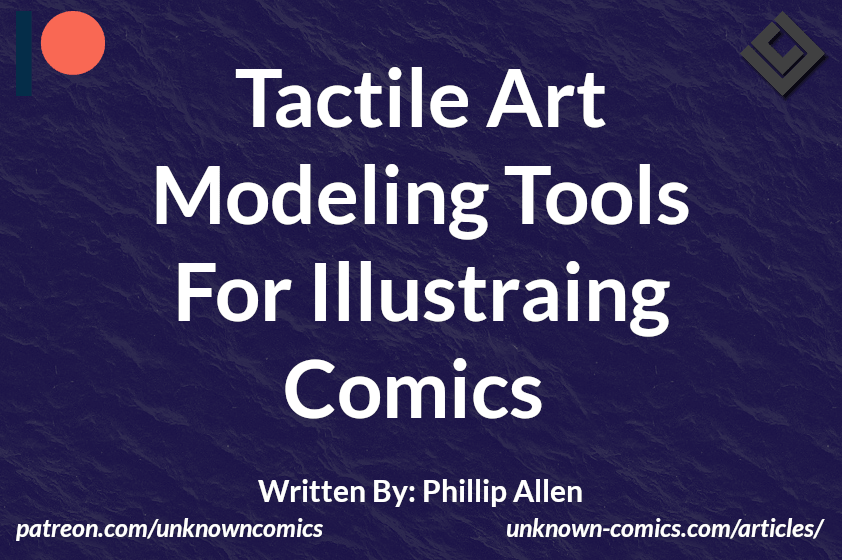When trying to figure out how to draw your comics, the more tools you have at your disposal, or that you are aware of, can only help. That is why I am writing this article on the tactile art modeling tools for illustrating comics. What do I mean by tactile? It means that it’s something you can immediately see, touch, and direct with your very hands or by providing the necessary instructions to the person aiding you in the specific circumstance.
So, what would you need a tactile art modeling tool for when it comes to illustrating your comic? As far as I can tell, you would at the very least need to have solutions for both the human form and different types of scenery.
I considered mentioning reference images, but since these can’t always be altered to suit your specific needs, I decided to exclude them.
I know I may be stretching the definition of tools throughout this particular article, but I wanted to make use of it mainly for my next article (which will cover digital tools for the same subject matter). So keep an eye out for that one when it comes out in a couple of weeks.
For now, let’s talk about people and places.
Tactile Modeling Tools for Illustrating Human Poses in Comic
There are solutions that you may want to consider when looking to figure out how to find illustrative references for your comic that you can actively alter to suit your particular needs.
Based on my research for tactile modeling tools for illustrating comics for the human form, I’ve determined that you have a mirror, cameras, other people, and a layman.
Mirrors, Cameras & Other People
In short, when you are curious about how something would look like when trying to draw you have yourself, and the bodies of others at your disposal. As long as you can find someone willing to spend a few minutes to model for you, you should be able to direct them to take on a certain pose long enough for you to get a quick sketch for your project.
If you don’t have someone around, the option of using yourself remains. All you need is a big enough mirror, time, and a good eye to memorize and sketch the different poses you want to draw for your work.
If you would like to have the option of keeping a more permanent reference to this I would recommend taking pictures with a digital camera. Any modern smartphone should have a high enough quality camera installed to do the job.
A Layman
When trying to sketch the human form, it’s hard to ignore the help that a layman can bring. A layman, also referred to as a lay figure or a mannequin, are human-like dolls, with a head, limbs, hands, and feet that can be bent to the shape the user requires.
Laymen can vary in their design; some looking very plain with basic figures determining hands and feet, while others can have more distinct figures for faces, hands, feet, and even gender. I’ve seen some that can allow you to move individual fingers, equip different weapons, and more. This is a very great tactile model tool for illustrating human poses for comic creators. If you see one, you may want to consider picking one up!
Like the article so far? Support the production of more articles like this one!
Tactile Modeling Tools for Illustrating Scenery in Comics
Unless you want to recreate an exact street in the real world, you will need to have access to tools that will allow you to create custom scenery for your comic.
For this, I strongly recommend getting access to as many different shaped blocks and toys as you can.
Buildings
For buildings, I recommend cardboard boxes, toilet paper rolls, water bottles, and anything else that could take on the shape of a miniature building
Light Source
If you do not feel comfortable with imagining a light source for your scenery, a multi-jointed or flexible desk lamp stand can be a great way to simulate one.
Miscellaneous
For things like cars, foliage, and other things I would strongly recommend considering getting access to little toys. Toy cars, miniature train foliage, and other modeling components can be of great use to someone trying to quickly develop a custom scene.
In Conclusion
Overall this article works as a nice list of available tactile art modeling tools for illustrating comic characters and custom scenery. If you have any suggestions for any additional tools that other comic creators can take advantage of please leave a comment below!
In the next article, I’ll be covering some cool digital art modeling tools for illustrating comics! So be sure to look out for that!
Sign Up For
The Unknown Times!
Content Updates
Website News
Recommended Reading
And More to Come!
*Once every two weeks!*
Liked the article? Become part of my Patreon Community!
About The Author

Phillip Allen
Writer, Editor, and Founder of Unknown Comics
Hello there! My name is Phillip Allen and I'm the writer, editor, and founder of Unknown Comics. I am an aspiring comic book creator. In an attempt to learn how to create my own comic I came to learn just how few reliable resources existed out there. From a few books and unhelpful websites I decided to focus my attention on researching and writing a resource for both myself and the rest of the comic creating industry. This website and and its content is the result of all of that hard work.

